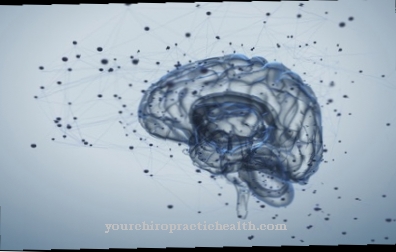In the Metabolism it is the conversion of biochemical substances by the enzyme system of the organisms. Intermediate products are formed, which are also known as metabolites. The entire metabolism is based on the constant metabolism of chemical substances.
What is Metabolism?

The term metabolism is used in biology and medicine and describes the conversion or breakdown of a chemical substance in the course of metabolism. In Greek, the term metabolism is also referred to as metabolism. The metabolism is necessary to maintain the vital functions of the organism.
There is the so-called catabolic and anabolic metabolism. In the context of catabolic metabolism, for example, high-energy, high-polymer bio-substances are broken down from food with the release of energy. The dismantling takes place in three stages. In this way, the individual building blocks are initially created from polysaccharides (multiple sugars), fats and proteins. In the case of polysaccharides, these are hexoses (glucose, fructose) and pentoses. Fats are broken down into fatty acids and glycerine and the proteins are in turn the source of individual amino acids. All these monomers are metabolites of the metabolism, since they can either be broken down further or contribute to the build-up of the body's own biological substances.
The anabolic metabolism ensures that the body's own complex compounds are built up from simpler starting materials. The metabolites of the catabolic metabolism are called catabolites and those of the anabolic metabolism are called anabolites. The interface between anabolic and catabolic metabolism is the so-called intermediate metabolism. Many metabolites are both the starting material of anabolic and catabolic processes.
Foreign substances are also metabolized in the body and converted into a water-soluble form that can be excreted. These foreign substances include drugs, but also poisons.
Function & task
The metabolism is of great importance for the body. The body is supplied with energy through the constant conversion of substances (during the breakdown of high-energy, high-molecular biomolecules). The chemical energy of the starting compounds is released and converted into heat and kinetic energy to maintain physical functions. This creates carbon dioxide and water at the lowest end of the catabolic processes. This breakdown takes place via several intermediate substances, which can also be reintegrated into anabolic body processes as so-called metabolites. The energy released is temporarily stored in a phosphate bond during the breakdown processes (see ATP, GTP or others).
By splitting the phosphate bond, energy is released which can be converted back into chemical energy of a macromolecule as part of an anabolic process. Catabolic and anabolic metabolic pathways are therefore closely linked.
Furthermore, at every stage of a catabolic or anabolic metabolic pathway, metabolites are formed that are either broken down or used to build more complex compounds. The metabolic pathway from which the individual metabolite originates is not decisive. This interface between catabolic and anabolic metabolism is called the intermediate metabolism.
The organism is always in a steady state of chemical substances that are introduced and removed. Animal organisms use the chemical energy of organic substances, which are broken down into simple inorganic substances. Plant organisms absorb solar energy in the form of light and convert it into chemical energy by building organic substances from inorganic substances.
In addition to metabolism in the course of normal metabolism, absorbed foreign substances are also metabolized. These metabolizations always take place in the liver. These are mostly detoxification reactions. Pharmaceuticals are also subject to these reactions. Overall, we speak of biotransformation. In a first phase, oxidation or reduction reactions or hydrolysis take place.
In the case of a primarily acting poison or a primarily acting medicinal substance, the effect decreases. However, if the drug is absorbed as a prodrug, it will only become effective after the phase 1 reactions. The same thing can happen with a primarily non-toxic substance. Some toxins only develop in the body through appropriate metabolism. In a second phase, the metabolites that are formed in phase 1 are made water-soluble through further transformations so that they can be excreted via the kidneys.
Illnesses & ailments
In the context of metabolism and the corresponding metabolizations, considerable health problems can arise if a metabolite cannot be broken down or only poorly. If, on the contrary, there are no reactions to the formation of certain important metabolites, health consequences can also be expected. In such situations there is very often a genetic defect or a chromosome change.
Certain enzymes cannot be produced or can only be produced inadequately. The same effect is caused by a defective enzyme. Many metabolic diseases therefore show an accumulation of certain metabolites. In other diseases, important metabolites are not even formed. In both cases the chain of complex reactions is interrupted and some vital reactions no longer take place.
In so-called storage diseases, certain substances or metabolites accumulate more and more in the cells or outside the cells. This often leads to significant organ damage. In the case of poisons and pharmaceuticals, the metabolism should generally lead to the degradation of the substances, thereby weakening their effect. However, there are also cases where the metabolic processes turn relatively harmless starting materials into active metabolites, which only develop their toxic effect at this stage. The metabolism processes for foreign substances are unspecific and therefore always only follow a scheme. It can therefore sometimes happen that the metabolism process of these particular substances is the real problem.

























.jpg)

.jpg)
